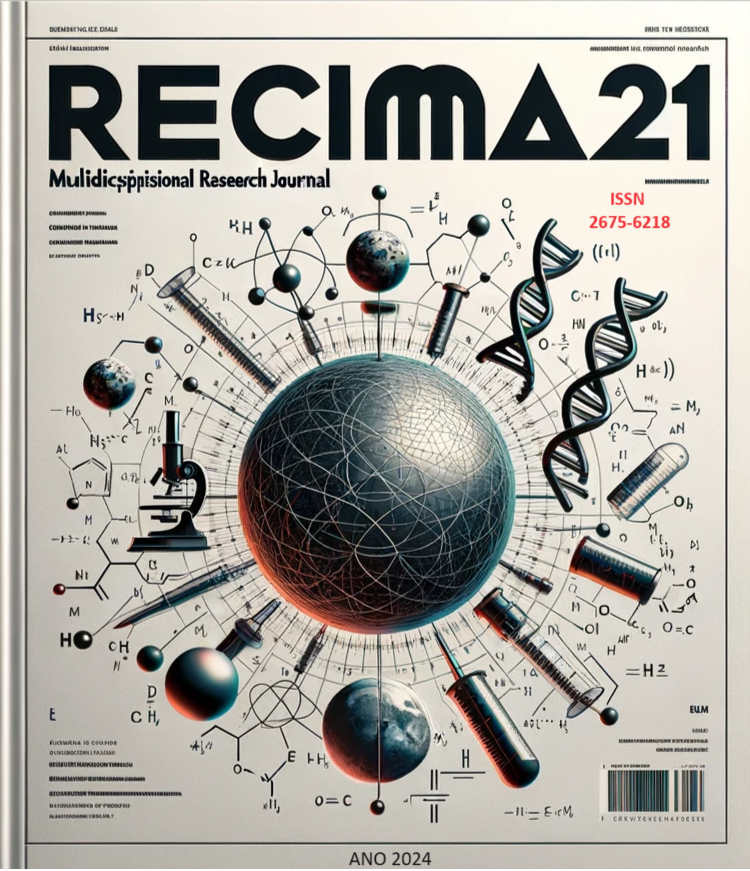REFLEJOS PRIMITIVOS: TERAPIAS OPTOMÉTRICAS
DOI:
https://doi.org/10.47820/recima21.v5i3.5006Palabras clave:
Reflejos primitivos; Desarrollo; Optometría.Resumen
Los reflejos primitivos son una parte integral del mecanismo de supervivencia de un recién nacido y se integrarán naturalmente durante los primeros años de vida a medida que surjan reflejos posturales más maduros. Cuando el reflejo primitivo no está integrado, puede haber una falla en el desarrollo de las habilidades motoras, el procesamiento cognitivo y la regulación emocional del individuo. La persistencia de los reflejos primarios puede indicar un desarrollo neurológico deficiente e inmadurez del sistema nervioso. A través de revisiones bibliográficas, se demuestran correlaciones entre los reflejos primitivos retenidos y los trastornos en las habilidades de desarrollo de los niños. En un entorno multidisciplinario, el optometrista es muy importante, ya que este es el agente de la atención primaria de la visión, pudiendo realizar pruebas evaluativas y planificar terapias para la integración de estos reflejos primitivos, proporcionando así una mejor calidad de vida al paciente. Se necesita más investigación sobre la utilidad de las técnicas de integración de reflejos para mejorar el funcionamiento motor, cognitivo y emocional y mejorar la calidad de vida en general.
Descargas
Citas
ANDRICH, P. et al. Statistical Relationships Between Visual Skill Deficits and Retained Primitive Reflexes in Children. Optometry & Visual Performance, v. 6, n. 3, 2018. https://www.ovpjournal.org/uploads/2/3/8/9/23898265/63c.pdf Acesso em: 05 set. de 2023.
BERNE, Samuel A. The Primitive Reflexes: Considerations in the Infant. Optometry & Vision Development, v. 37, n. 3, 2006. from http://c.ymcdn.com/sites/www.covd.org/resource/resmgr/ovd37-3/139-146berneessay.pdf. Acesso em: 02 nov. 2023.
CENTERS FOR DISEASE CONTROL AND PREVENTION [CDC]. Increasing prevalence of parent-related attention-deficit/hyperactivity disorder among children—United States, 2003 and 2007. Morbidity and Mortality Weekly Report, v. 59, n. 44, p. 1439-1443, 2010. http://www.ncbi.nlm.nih.gov/pubmed/21063274 Acesso em: 04 set. 2023.
DOMINGO-SANZ, Vicente A. Inhibition of Primitive Reflexes and Its Relationship with Visual Projection in Children and Adolescents. Optometry & Visual Performance, v. 10, n. 4, 2022. https://www.oepf.org/wp-content/uploads/2021/01/Web-OVP10-4-Full-Issue.pdf#page=14 Acesso em: 04 set. 2023.
FIORENTINO, Mary R. Reflex Testing Methods for Evaluating CNS Development. American Journal of Physical Medicine & Rehabilitation, v. 53, n. 6, p. 300, 1974. https://journals.lww.com/ajpmr/citation/1974/12000/reflex_testing_methods_for_evaluating_c_n_s_.19.aspx Acesso em: 04 set. 2023.
GIEYSZTOR, Ewa et al. Pelvic symmetry is influenced by asymmetrical tonic neck reflex during young children’s gait. International Journal of Environmental Research and Public Health, v. 17, n. 13, p. 4759, 2020. DOI: https://doi.org/10.3390/ijerph17134759 DOI: https://doi.org/10.3390/ijerph17134759
GODDARD B. S. Attention, Balance and Coordination: The ABC of Learning Success. Chichester, UK: John Wiley and Sons, 2017. Doi: 10.1002/9781119164746. DOI: https://doi.org/10.1002/9781119164746
GODDARD B. S.; DUNCOMBE, R.; PREEDY, P.; GORELY, T. Neuromotor readiness for school: the primitive reflex status of young children at the start and end of their first year at school in the United Kingdom. Education, v. 3, n. 13, p. 1–14, 2021. DOI: 10.1080/03004279.2021.1895276. DOI: https://doi.org/10.1080/03004279.2021.1895276
GONZÁLEZ, Sergio Ramírez et al. The Correlation between Primitive Reflexes and Saccadic Eye Movements in 5th Grade Children with Teacher-Reported Reading Problems. Optometry & Vision Development, v. 39, n. 3, 2008. https://web.p.ebscohost.com/abstract?direct=true&profile=ehost&scope=site&authtype=crawler&jrnl=15574113&asa=Y&AN=34757635&h=oHvQOvrsWmLM0oOnJdl0QsT9uyzRUv57DAEKuK0ncjfpzpwR9CrZ487R8b4RiN7bM3B7qd9U4dT3eeOG5s0JBw%3d%3d&crl=c&resultNs=AdminWebAuth&resultLocal=ErrCrlNotAuth&crlhashurl=login.aspx%3fdirect%3dtrue%26profile%3dehost%26scope%3dsite%26authtype%3dcrawler%26jrnl%3d15574113%26asa%3dY%26AN%3d34757635 Acesso em: 04 set. 2023.
GRZYWNIAK, C. Role of Early-Childhood Reflexes in the Psychomotor Development of a child, and in learning. Acta Neuropsychologica, v. 14, n. 2, 2016. DOI:10.5604/17307503.1213000
KALEMBA, A. et al. The correlation between residual primitive reflexes and clock reading difficulties in school-aged children—A pilot study. International Journal of Environmental Research and Public Health, v. 20, n. 3, p. 2322, 2023. https://doi.org/10.3390/ijerph20032322 DOI: https://doi.org/10.3390/ijerph20032322
KOH, P. S.; RAFFENSPERGER, J. G.; BERRY, S.; LARSEN, M. B.; JOHNSTONE, H. S.; CHOU, P. et al. Long-term outcome in children with opsoclonus-myoclonus and ayaxia and coincident neuroblastoma. Journal of Pediatric, v. 125, p. 712-716, 1994. https://doi.org/10.1016/S0022-3476(06)80167-8 DOI: https://doi.org/10.1016/S0022-3476(94)70062-1
KONCZAK, Jürgen. On the notion of motor primitives in humans and robots. [S. l.: s. n.], 2005. https://web-archive.southampton.ac.uk/cogprints.org/4963/1/konczak.pdf Acesso em: 15 out. 2023.
LENNERSTRAND, G. et al. Functional Basis of Ocular Motility Disorders: Proceedings of a Wenner-Gren Center and Smith-Kettlewell Eye Research Foundation. In: International Symposium, Held in Wenner-Gren Center, Stockholm, 31 August-3 September 1981. (No Title), 1982 https://cir.nii.ac.jp/crid/1130000798132184832. Acesso em: 30 set. 2023.
MATHES P. G.; DENTON, C. A. The prevention and identification of reading disability. Semin pediatr neurol., v. 9, n. 3, p. 185-91, 2002. https://doi.org/10.1053/spen.2002.35498 DOI: https://doi.org/10.1053/spen.2002.35498
MELILLO, Robert. Persistent primitive reflexes and childhood neurobehavioral disorders. Neuroplasticity in learning and rehabilitation, p. 65, 2016. https://www.researchgate.net/profile/JoelBrock2/publication/316137269_Outcomes_in_traumatic_brain_injury_mild_traumatic_brain_injury_and_concussion/links/6260decaee24725b3eb9b737/Outcomes-in-traumatic-brain-injury-mild-traumatic-brain-injury-and-concussion.pdf#page=75 Acesso em: 30 set. 2023.
PAPALIA, D. E.; FELDMAN, R. D. Desenvolvimento humano - Dados eletrônicos. Porto Alegre: AMGH, 2013. https://d1wqtxts1xzle7.cloudfront.net/62107146/Livro_Papalia_Desenvolvimento_HumanoTEMA_3_4_E_520200215-80207-6nzloe.pdf?1581784485=&response-content-disposition=inline%3B+filename%3DHumano_12a_edicao.pdf&Expires=1698772339&Signature=e-AREzxrsFi7gnyqKABxt28Z3XSwqkSUHNa94SoJ4tU6-86BYM1hq1eIKPi4MjxSoiwCaB3Rt7PsrAYimGnPQgw0A1gHiZwfo3H~H58yC8yJCCr5fmGo0JNpxuwHRBbqg2sjtPxBMMeQ8noiEn4lwtGJwzJU38sIrA18-Vgeb9r~QMRi23zQ~mCxbtKH0af9O2MzN5jaQ1~XtD39HLCt0ONMkNI32DalxxRmcTNlq2v~PWMFH9MylBWra3jkSp2m356iYlA5jq-zLXhOPqCX~BuYXf8E57H4YGj0~srIrZPTA-TQGwe5sxoMfPhbmiM4xjZksB4K0xDNljfyipCcA__&KeyPairId=APKAJLOHF5GGSLRBV4ZA. Acesso em: 28 set. 2023.
PECUCH A. et al. Psychomotor disorders assesment in 4–6 year-old children with INPP test battery. Nurs. Public Health, v. 8, p. 11–20, 2018. DOI: 10.17219/pzp/75487 DOI: https://doi.org/10.17219/pzp/75487
TEICHER, M. H.; TOMODA, A.; ANDERSEN, S. L. Neurobiological consequences of early stress and childhood maltreatment: are results from human and animal studies comparable? Ann N Y Acad Sci., v. 1071, p. 313-23, jul. 2006. DOI: 10.1196/annals.1364.024. DOI: https://doi.org/10.1196/annals.1364.024
URZÊDA, Renan Neves et al. Reflexos, reações e tônus muscular de bebês prétermo em um programa de intervenção precoce. Revista Neurociências, v. 17, n. 4, p. 319-325, 2009. https://doi.org/10.34024/rnc.2009.v17.8524 DOI: https://doi.org/10.34024/rnc.2009.v17.8524
VILLANEDA, A. Primitive reflexes. Integrated Learning Strategies, p. 1-37, 2018.
WAHLBERG, Timothy; IRELAND, Dennis. Can replicating primary reflex movements improve reading ability?. Optometry & Vision Development, v. 36, n. 2, 2005.
ZAFEIRIOU D. I. Primitive reflexes and postural reactions in the neurodevelopmental examination. Pediatr Neurol., v. 31, n. 1, p. 1-8, jul. 2004. DOI: 10.1016/j.pediatrneurol.2004.01.012 DOI: https://doi.org/10.1016/j.pediatrneurol.2004.01.012
ZIELIŃSKA, Maja; GODDARD BLYTHE, Sally. School functioning of students with neuromotor immaturity. International Journal of Pedagogy, Innovation and New Technologies, n. 7, n. 2, p. 40-46, 2020. DOI: 10.5604/01.3001.0014.6864. DOI: https://doi.org/10.5604/01.3001.0014.6864
Descargas
Publicado
Cómo citar
Número
Sección
Categorías
Licencia
Derechos de autor 2024 RECIMA21 - Revista Científica Multidisciplinar - ISSN 2675-6218

Esta obra está bajo una licencia internacional Creative Commons Atribución 4.0.
Os direitos autorais dos artigos/resenhas/TCCs publicados pertecem à revista RECIMA21, e seguem o padrão Creative Commons (CC BY 4.0), permitindo a cópia ou reprodução, desde que cite a fonte e respeite os direitos dos autores e contenham menção aos mesmos nos créditos. Toda e qualquer obra publicada na revista, seu conteúdo é de responsabilidade dos autores, cabendo a RECIMA21 apenas ser o veículo de divulgação, seguindo os padrões nacionais e internacionais de publicação.

 Clique para ver detalhes
Clique para ver detalhes 











